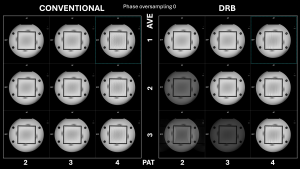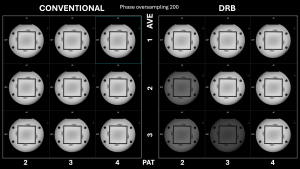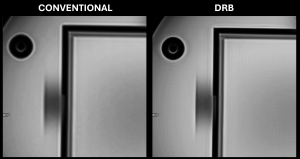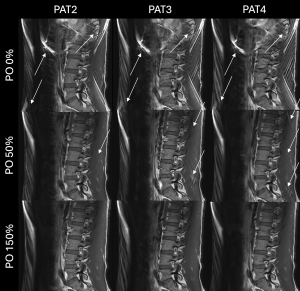Signal intensity - Phantom
Without DRB enabled, no parameter (PAT, PO, AVE) had a significant effect on signal intensity at ROIs near the edges of the phantom. However, increasing PO resulted in a minimal increasement of signal at ROI in the middle of the phantom.
With DRB enabled, increasing the PAT factor resulted in a significant increasement in signal intensity. Conversely, increasing the number of averages resulted in a signal decrease, whenever the number of averages was greater or equal to the PAT factor. Increasing PO had no significant effect on the signal. These phenomena were consistently observed in all ROIs.
Enabling DRB reduced the signal significantly when the number of averages was set as equal to or higher than the PAT factor.
SNR - Phantom
Without DRB enabled, increasing the PAT factor resulted in a decrease of SNR near the edges and in the middle of the phantom. However, the magnitude of the observed effect was greater in the centre of the phantom. Increasing AVE had no significant effect on SNR near the edges of the phantom (p = 0.30). Conversely, increasing AVE had an increasing effect on SNR in the middle of the phantom. Increasing PO had an increasing impact on SNR in all considered regions.
With DRB enabled, increasing the PAT factor had no significant effect on SNR. Increasing the number of averages resulted in a deterioration of SNR. Increasing PO had no significant effect on SNR, except for a minimal increase in the middle ROI.
Artifacts - Phantom
Increasing the PAT factor stimulated an increasing level of g-factor noise when PO was not applied. With DRB, the appearance of g-factor noise was unexpected. Increasing the number of averages did slightly decrease the severity of the artifact but increasing PO removed it. With PO of 200, no g-factor noise was visually detectable. The numerical decrease of signal intensity along increasing number of averages is also clearly visible. For number of averages of three combined with PAT factor of two, an unexpected artifact mimicking a phase shift of 180 degrees was visible. With PO of 200, no phase shift was visible but the signal decrease remained.


The noise in DRB images displayed artificial texture, mimicking nearby structure boundaries. Despite the similar field of view (FOV) and matrix size, Gibbs ringing artifact was milder while using DRB, and DRB image appears visually assessed sharper.

Volunteer
Regarding SNR, no deviating effects to that of the phantom study were observed. Also, artifacts displayed similar behavior.
